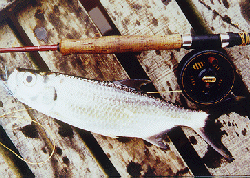
About Sport Fish you will find in our sunny tropical paradise
 |
Local Fish
About Sport Fish you will find in our sunny tropical paradise |
 Tarpon - Megalops cyprinoides
Tarpon - Megalops cyprinoides
Indo-Pacific Tarpon, bulan. This Indo-Pacific tarpon is almost identical to its Atlantic brother in characteristics, except the main difference is the size. It doesn't grow as large. It is found up to 5kgs, but normally a 1-2kg fish is a fine specimen. It is a bony fish, therefore not sought after as an estuary food fish. Ultra light tackle game On light tackle it makes a great sport fish! When the tarpon hits the sub-surface lures, the flash of the silvery body can be seen as it hits the lure coming from the side. If it misses, it will turn back, and hit the lure from the opposite direction, sometimes as often as 3 or 4 times before getting hooked up! Pretty thrilling stuff! When the tarpon go after a lure as a school, they take turns hitting the lure, swimming in a vertical circle till one of them gets hooked up! When the lure is hit, a really solid thump is felt, often eliciting an oomph from the angler! A sensational jumper, it will jump until exhausted trying to free itself. When it fights deep, the tarpon really slugs it out, giving the angler a run for his money. The tarpon has a lot of stamina, often taking several minutes before it tires enough to be gently landed, unhooked and released. Found along the coast The tarpon are found mainly in the rivers, lagoons, estuaries and mangrove swamps along the east and west coast of Peninsula Malaysia and also along the coast lines of East Malaysia. As they are andromous fish they can be found quite far up the river in the brackish and freshwater. They can be often seen schooling in a group, rising to take air with dorsal fin and tail breaking the surface as they dive down. Then they leave a bubble trail, expelling the air taken in. Tarpon often school in this manner in the current of the deep "lubuks" or next to the snags of the estuary river, especially when the current is flowing. When this behaviour is observed, they are normally in a feeding mood. Easy to spot In the open rivers they can be seen rising shoals when the current slows to a stand still during the change of tide. At other times they can be seen rising at random, scattered around the place, especially in the open waters of the lagoons. When they use their tails to smack the surface, it has been observed that they normally do not take lures. Even if they are not rising but their hang out is known, it is possible to still hook them up with the right lure retrieval method, namely vary the retrieve, make it steady, erratic or very slow with a lot of drift till the tarpon strikes. When they stop hitting, start all over again to find out what method they will hit now. Sometimes they will hit a retrieval they would not touch earlier on. Also try letting the lure sink to get it deep, as they may be holding deep and will not rise to hit the lure. Sinking fly lines in this circumstance is invaluable to the fly fishermen Fly fishing thrills For the fly fishermen, sinking flies like the clouser minnow, deceiver, pink thing and whistler have proven potent for tarpon. Sometimes they will take surface flies like poppers and dalhberg divers, but sub-surface and weighted flies are the biggest producers. When using flies and hard lures the retrieval must give the lures an injured bait fish action, retrieve jerkily and occasionally stop and let the lure sit still for 2 or 3 seconds. Often the tarpon will hit the lure when it is static. When using surface lures, this results in spectacular and exciting hits! Tarpon will also take small live bait. Casting with lures Occasionally a big tarpon will hit a hard lure, like minnows or high vibration type spoons. I have landed them on small plastics too. Most of their food are small bait fish, so the lures should match the size of the food. When they will not take hard lures, they can be taken on flies on casting gear by tying a suitable fly about a foot or two above a small sinker. The small sinker will allow the angler to cast on light spinning or baitcasting gear. The tarpon has no teeth but its sand paper mouth requires the use of heavy mono, 15-20 lb is sufficient. After a few fish the mono would be frayed, and the frayed portion would have to be cut off and retied. With its bony mouth, obtaining a firm hook set can be a problem at times, but having a good hook-set technique sorts out this problem. Casting/spinning tackle in the 4-6lb range is ideal for our tarpon as it is not a dirty fighter, staying clear of snags. For the fly fishermen the light to medium fly rods from 3-6 weight are ideal. The tarpon is a great little sportfish, always there for the light tackle sport angler, especially those who release their catch. |